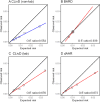Comparison of models to predict incident chronic liver disease: a systematic review and external validation in Chinese adults
- PMID: 39736748
- PMCID: PMC11686935
- DOI: 10.1186/s12916-024-03754-9
Comparison of models to predict incident chronic liver disease: a systematic review and external validation in Chinese adults
Abstract
Background: Risk prediction models can identify individuals at high risk of chronic liver disease (CLD), but there is limited evidence on the performance of various models in diverse populations. We aimed to systematically review CLD prediction models, meta-analyze their performance, and externally validate them in 0.5 million Chinese adults in the China Kadoorie Biobank (CKB).
Methods: Models were identified through a systematic review and categorized by the target population and outcomes (hepatocellular carcinoma [HCC] and CLD). The performance of models to predict 10-year risk of CLD was assessed by discrimination (C-index) and calibration (observed vs predicted probabilies).
Results: The systematic review identified 57 articles and 114 models (28.4% undergone external validation), including 13 eligible for validation in CKB. Models with high discrimination (C-index ≥ 0.70) in CKB were as follows: (1) general population: Li-2018 and Wen 1-2012 for HCC, CLivD score (non-lab and lab) and dAAR for CLD; (2) hepatitis B virus (HBV) infected individuals: Cao-2021 for HCC and CAP-B for CLD. In CKB, all models tended to overestimate the risk (O:E ratio 0.55-0.94). In meta-analysis, we further identified models with high discrimination: (1) general population (C-index ≥ 0.70): Sinn-2020, Wen 2-2012, and Wen 3-2012 for HCC, and FIB-4 and Forns for CLD; (2) HBV infected individuals (C-index ≥ 0.80): RWS-HCC and REACH-B IIa for HCC and GAG-HCC for HCC and CLD.
Conclusions: Several models showed good discrimination and calibration in external validation, indicating their potential feasibility for risk stratification in population-based screening programs for CLD in Chinese adults.
Keywords: Chinese; Chronic liver disease; External validation; Hepatocellular carcinoma; Risk prediction; Systematic review.
© 2024. The Author(s).
Conflict of interest statement
Declarations. Ethics approval and consent to participate: Central ethical approvals were obtained from Oxford University and the China National CDC. Approvals were also obtained from institutional research boards at the local CDCs in the ten areas: Qingdao, Qingdao CDC; Heilongjiang, Provincial CDC; Hainan, Provincial CDC; Jiangsu, Provincial CDC; Guangxi, Provincial CDC; Sichuan, Provincial CDC; Gansu, Provincial CDC; Henan, Provincial CDC; Zhejiang, Provincial CDC; and Hunan, Provincial CDC. The study protocol of the resurvey was approved by the Peking University Institutional Review Board (No. IRB00001052-20040), and separate written informed consent was obtained from all participants before accelerometer data collection. Consent for publication: Not applicable. Competing interests: The authors declare that they have no competing interests.
Figures




Similar articles
-
Liver elastography-based risk score for predicting hepatocellular carcinoma risk.J Natl Cancer Inst. 2025 Apr 1;117(4):761-771. doi: 10.1093/jnci/djae304. J Natl Cancer Inst. 2025. PMID: 39576686
-
External validation of the PAGE-B score for HCC risk prediction in people living with HIV/HBV coinfection.J Hepatol. 2023 May;78(5):947-957. doi: 10.1016/j.jhep.2022.12.029. Epub 2023 Jan 21. J Hepatol. 2023. PMID: 36690280
-
Viral Load-Based Prediction of Hepatocellular Carcinoma Risk in Noncirrhotic Patients With Chronic Hepatitis B : A Multinational Study for the Development and External Validation of a New Prognostic Model.Ann Intern Med. 2024 Oct;177(10):1308-1318. doi: 10.7326/M24-0384. Epub 2024 Sep 17. Ann Intern Med. 2024. PMID: 39284185
-
Prognostic models for newly-diagnosed chronic lymphocytic leukaemia in adults: a systematic review and meta-analysis.Cochrane Database Syst Rev. 2020 Jul 31;7(7):CD012022. doi: 10.1002/14651858.CD012022.pub2. Cochrane Database Syst Rev. 2020. PMID: 32735048 Free PMC article.
-
Evaluating the predictive value of clinical models for HBV-related hepatocellular carcinoma: A meta-analysis.Front Med (Lausanne). 2025 Feb 21;12:1529201. doi: 10.3389/fmed.2025.1529201. eCollection 2025. Front Med (Lausanne). 2025. PMID: 40061381 Free PMC article.
Cited by
-
Metformin: An Old Drug with New Tricks-Promising Role in Vascular Aging and Cardioprotection.Drugs Aging. 2025 Aug;42(8):709-731. doi: 10.1007/s40266-025-01215-3. Epub 2025 Jun 5. Drugs Aging. 2025. PMID: 40471543 Review.
-
Prediction of major liver-related events in the population using prognostic models.Gastroenterol Rep (Oxf). 2025 Mar 14;13:goaf028. doi: 10.1093/gastro/goaf028. eCollection 2025. Gastroenterol Rep (Oxf). 2025. PMID: 40093587 Free PMC article. Review.
References
-
- Global incidence, prevalence, years lived with disability (YLDs), disability-adjusted life-years (DALYs), and healthy life expectancy (HALE) for 371 diseases and injuries in 204 countries and territories and 811 subnational locations, 1990–2021: a systematic analysis for the Global Burden of Disease Study 2021. Lancet (London, England). 2024;403(10440):2133–61. https://pubmed.ncbi.nlm.nih.gov/38642570/. - PMC - PubMed
-
- Wang MM, Wang GS, Shen F, Chen GY, Pan Q, Fan JG. Hepatic steatosis is highly prevalent in hepatitis B patients and negatively associated with virological factors. Dig Dis Sci. 2014;59(10):2571–9. - PubMed
Publication types
MeSH terms
LinkOut - more resources
Full Text Sources
Medical
Research Materials
Miscellaneous

